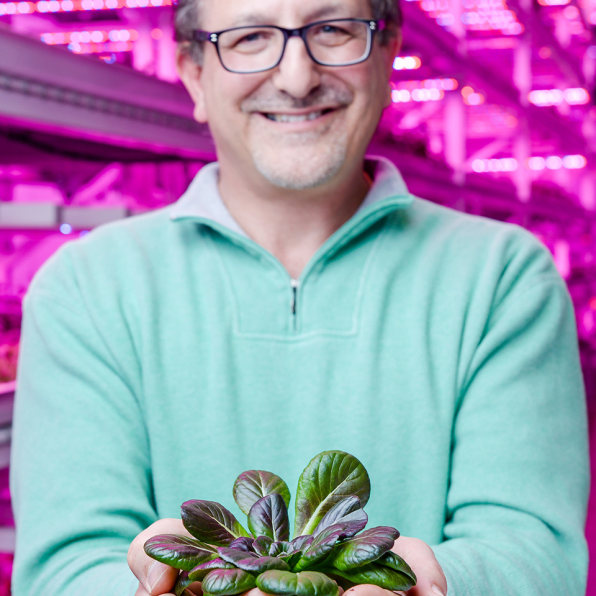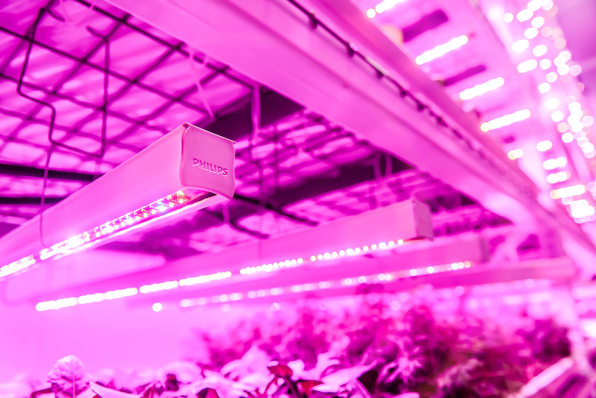Magnolia Farms Bedroom
In a windowless warehouse just outside of Chicago, where today's forecast is for below-freezing temperatures, Green Sense Farms grows leafy greens and herbs all year around. They sell their bounty–protected from insects, disease and brutal winters–to grocers like Whole Foods and some local restaurants. Green Sense grows their soil-free produce (they use coconut husk instead) in indoor growing towers. Beneath 30 foot ceilings, rows and rows of produce are stacked and CO2 levels, water, lighting, and humidity are precisely controlled.
"At capacity, we're producing about three to four million pounds a year," said Robert Colangelo, the president and founder of Green Sense Farms. With their current footprint–30,000 square feet–Green Sense can grow fresh produce that can be distributed within 100 miles to 20 million people.

Their success is another sign that the vertical urban farming movement is beginning to scale. In Cambridge, Massachusetts, MIT's Media Lab is developing an open source version, known as City Farm. In Japan, just 60 miles from where the 2011 Fukushima nuclear disaster occurred, inside of a former silicon chip manufacturing facility, Fujitsu grows 3000 heads of lettuce a day that sell for three times the price of other lettuce.
Growers say they want to grow nutritious food in a new, sustainable way, and supplement field farms and greenhouses. They believe the technique can revolutionize farming in crowded urban metropolises, during cold winters, and in impoverished parts of the world. And, the growers add, their produce is already in demand because it's local, available year around, and frankly, pristine.
"In the field–there's pests, there's animals, there's fungus, and there's weather–the sun may shine, it may not," said Colangelo. "We see this as the future of farming."
Two Visions
Because City Farm is funded and backed by MIT, Harper says he is in a unique position to make his technology open source, to prototype rapidly and then spread it far and wide.
At the moment, he is working with universities and governments in Dubai, Accra, Guadalajara, and Detroit to develop vertical growing laboratories launching starting this January. In exchange for providing them with his technology, he hopes that each group will share their "recipes" for serving locals.
"We can optimize for different things," he said. "Like power use or water use–this is about harnessing the power of computing for food. Agriculture is thousands of years old but it's only in recent times that we've been able to quantify a lot of the things around production."
And City Farm, Harper said, is trying to be the Linux of the vertical urban farm world.
"We're creating an OS that is open to the world," he said. "That will allow us to scale up faster."
If City Farm wants to be Linux, Green Sense would be happy to become the Windows of vertical urban farming. "Our number one goal is to be profitable," Colangelo said. "We're not doing this to solve world hunger–we're doing this to be a commercially viable farm."
To be sure, Green Sense wants to grow nutritious food, and do so in a sustainable, profitable manner. And, of course, it wants to be cool.
"We want to advance farming and be innovative just like Tesla has done with the electric car," he said.
But is there anything unhealthy or worrisome about growing crops in a sterile atmosphere, completely protected from natural elements, devoid of all sunlight, and in some cases, soil?
"You would think, if it doesn't have sunlight, it can't possibly be nutritious, but the reality [is that] plants only harvest 10% of the sun's rays, which we can recreate in the lab," Harpers said. "There is absolutely no nutritional difference between plants grown in sunlight and under an LED."
Colangelo goes further, arguing his produce is better than vegetable grown the old fashioned way.
"Anybody who comes into this farm sees the high level of cleanliness here," he said. "And when they eat right of the rack they can see the precise nature in which this has been grown."
Others are more skeptical of the health issues and the costs.
"I worry about the energy cost of inputs–light, water, nutrients," said Marion Nestle, a professor of nutrition at New York University and the author of Food Politics and What to Eat. "I also worry about the nutrients in soil that aren't reproduced in artificial systems. And then, there's the taste issue. Soil influences taste."

Still, Nestle said that this sort of farming may have a place in the urban world.
"If you live in a city and don't have access to soil, I suppose this is an alternative that could be considered," she said.
"The concern is there," said Gus van der Feltz, the global director of city farming for multinational lighting and tech company Philips. "If you don't use sun or soil what do you lose? Providing the right kind of environment and nutrients to the plant is important and we are working on that."
(Phillips has been actively working for more than seven years to develop LED lights that are suitable and cost effective for vertical urban farming. Green Sense, along with a number of other vertical farmers, are already successfully using their lighting products.)
As far as the energy trade-offs go, Colangelo of Green Sense says it's difficult to make comparisons between vertical farming and conventional farming.
"I would say honestly that no one has done a good cost analysis on this," he said.
The big energy commitments for conventional farmers include powering tractors and other equipment–something an indoor vertical farm does not need to worry about, Colangelo said.
"Plus, depending on the weather you could lose your entire crop," he said. "There's reliability here."
One major cost for vertical farms is lighting. LED lights were a significant upfront cost for Green Sense, Colangelo admitted. But while expensive, they are also easy to maintain and provide good long-term value, he said.
And there are clear limitations to vertical farming. For instance, It isn't practical to grow plants that require more space, like tomatoes or grains, in a stacked system. It's not a universal solution for hunger, but increased access to greens can help public health: Dark leafy greens (as opposed to the corn and potatoes that Americans favor) are known to reduce the risk of cardiovascular disease. A little competition between open-source supporters and big business might help us get there.
Source: https://www.fastcompany.com/3039087/vertical-farms-will-be-big-but-for-who

0 Komentar